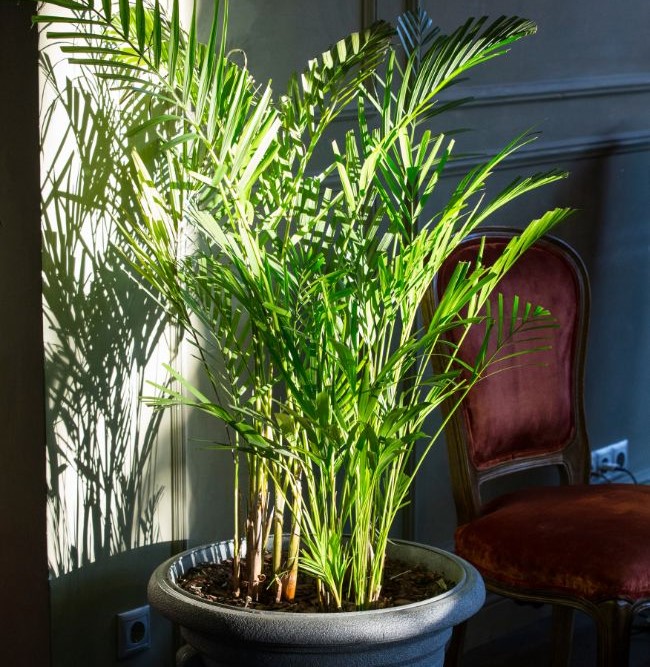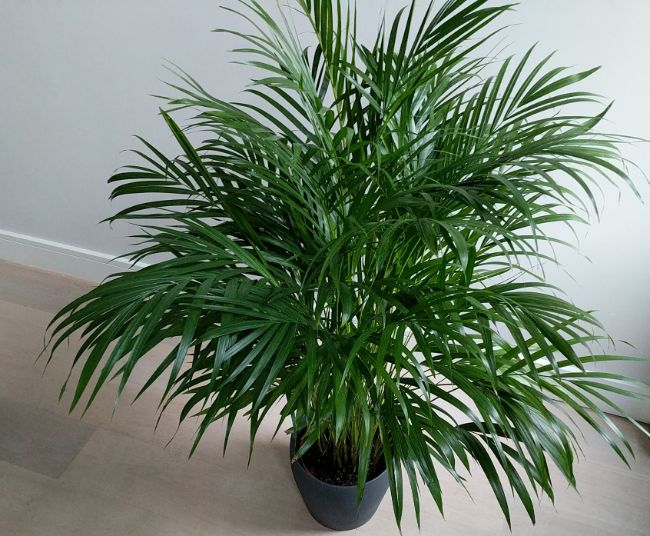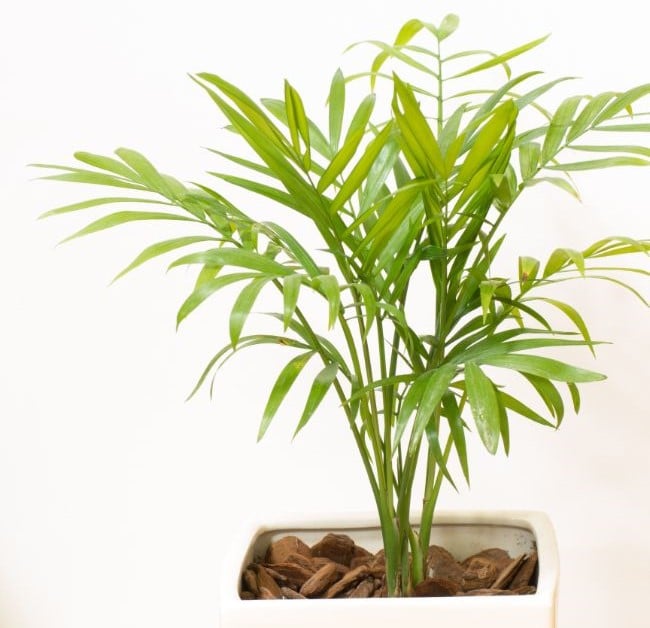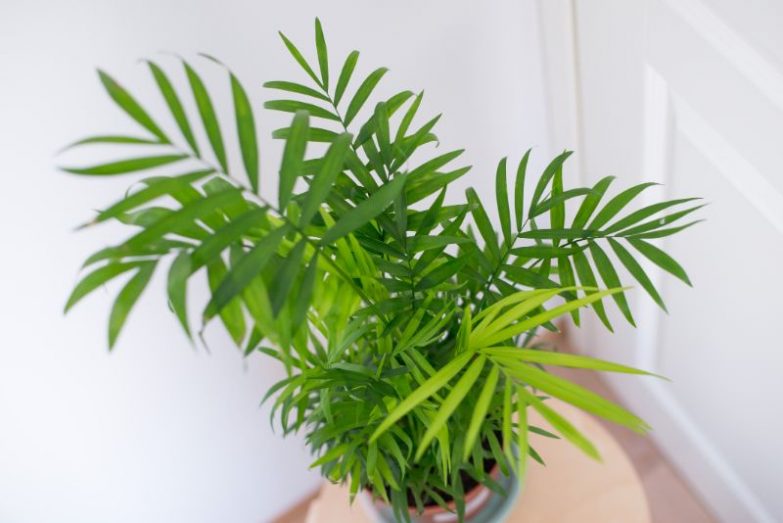A Palm Tree’s friendly arched fronds can bring our homes the relaxed tropical feeling of a permanent vacation. Indoors, these light-loving plants are often less relaxed in their requirements, however, and can decline despite our best intentions. In this article, we’ll look at why your indoor palm tree is dying and how to bring it back to health.
Why is your indoor palm tree dying? Palms need bright, indirect light and a stable environment with warm temperatures and moist, well-draining soil. Fertilization, humidity, repotting, and pest issues are important factors. Some palms are difficult to sustain indoors, but adaptable varieties recover and thrive with proper care.
Types Of Palms
Palm Trees can be difficult to identify but generally need similar care. Some species adapt more easily to indoor living than others.
The easiest group to keep indoors can adapt to lower light. The slow-growing Kentia Palm (Howea forsteriana) and the Parlor Palm or Neanthe Bella (Chamaedorea elegans) grow slowly and are tolerant of less-than-ideal conditions. The popular Bamboo Palm (Chamaedorea seifrizii) is another durable choice.
Other Palms can make nice indoor houseplants if they get enough light. These include the Chinese Fan Palm (Livistona chinensis), Spindle Palm (Hyophorbe verschaffeltii), Lady Finger Palm (Rhapis excelsa), and the relatively fast-growing Fish Tail Palm (Caryota mitis).
Majesty and Areca Palms are more challenging to keep in good condition indoors. These widely available palms need plenty of light, high humidity and continually moist soil to keep them looking their best. Don’t let that put you off if you’d like more of a challenge.
Treatment Basics
Even if your Palm Tree isn’t suddenly stricken, inadequate conditions can result in your indoor palm tree dying slowly, one frond at a time. The best solution is to check the roots and revisit the care you give it. Palms don’t like being moved, so don’t rush to relocate it. Choose the best spot you have available and leave it there.
Note: Palms raised outdoors in sunny climates can have a tough time adjusting to interior conditions. If possible, find out the background of a prospective plant before buying.
Palm trees recover slowly, so be patient. Use a sterilized blade to cut away dead or damaged fronds above the crown. If the frond is still partially green, you can trim off just the dead parts. Leave a small brown margin instead of cutting into the green area.
Bright Light

Indoor Palms like lots of bright, indirect light. Inadequate illumination is a primary cause of stress, so stick with the more adaptable varieties if your space doesn’t have sufficient light. Keep in mind that even species that can survive lower-light conditions generally appreciate more.
If your Palm isn’t getting enough light its fronds will slowly (or quickly) turn yellow and die. The plant may stretch toward the light source and become more likely to attract pests.
Hot, direct sunlight can scorch their fronds, but gentle early morning or late afternoon rays are welcome. A sunny East- or West-facing window or a few feet from a Southern exposure is usually ideal.
Sunlight intensity drops rapidly with distance, however. A skylight above a tall plant can be great, but it’s inadequate for shorter plants many feet away. Pay attention to changing seasons and dimming conditions over the winter … add a grow light if needed.
The Watering Balance
Palms like their soil to be consistently moist but never soggy. Water when the top ½ inch of the soil dries out. Moisture meter readings can vary by soil type, so it’s best to check manually. Read this article for more tips about watering your plants properly.
Soil Matters
Proper soil helps keep the moisture balance a Palm Tree needs. The medium should hold moisture but never become waterlogged. It must be well-draining and have enough aeration to provide consistent oxygen to the roots.
To provide these qualities, the potting mix should contain stable materials like perlite, coconut coir, or coarse sand. Organic components eventually break down and compact the soil. Read more about choosing the right potting soil in this article.
One potential issue is the buildup of salts and other root-toxic materials left over from watering and fertilizers. This shows up as browning leaf tips and stagnant growth. Make sure some excess water flows through the drainage holes each time you water, and flush the soil thoroughly every month or so. Distilled or filtered water can reduce the problem.
Overwatering
Palms want moist soil, but sitting in a soggy mix can be deadly. Sodden soil causes yellow or brown leaves – unfortunately, the same symptoms as underwatering. You need to investigate to stop your indoor palm tree dying.
This means literally getting to the root of the issue by unpotting your palm for inspection. If the normally white roots are brown or black, mushy, or smell of decay, overwatering is the problem and root rot was the unhappy result.
Cut away any decaying roots and replace their soil with fresh mix. Trim some foliage to let the plant use its energy to heal. Let the soil dry out before watering again … and proceed carefully. Learn more about fixing an overwatered plant here.
Pro Tip: Some growers drench the soil with hydrogen peroxide to add oxygen and kill pathogens. This also wipes out healthy bacteria, however.

Underwatering
It’s important not to let your Palm Tree’s soil dry out, either. Brown leaf tips are often a warning, and the entire frond will turn yellow or brown and crispy if the situation doesn’t improve.
Arid conditions also attract spider mites.
Humidity
Palms like more humidity than is found in most homes, but the easiest, lower-light varieties can adapt to less. The fronds of a plant being stressed by low air moisture will develop unsightly brown edges.
The ideal percentage is 50% humidity or more. If your air is dry, be extra careful to keep the soil consistently moist. A water tray placed nearby is also helpful.
Providing humidity in a heated home over the winter can be difficult. Some growers believe misting helps moisturize foliage, but it does little for overall humidity and may even promote fungal disease.
If you’re committed to keeping one of the more sensitive Palms healthy in dry air, a room humidifier is probably the best solution. Read more about other excellent ways to increase humidity for your indoor palms and other houseplants.
Other Stresses
Once you’ve reviewed your Palm Tree’s water and light conditions, double-check these factors:
Air Circulation And Drafts
Like most houseplants, Palms suffer and turn yellow or dry out from hot or cold drafts … but they also dislike stagnant air. If their air doesn’t circulate, they are more prone to stress and pest infestation. It’s a good idea to keep a gentle fan in operation.
Fertilization
Indoor Palms aren’t heavy feeders. Burned roots and brown leaf tips can result from too much fertilizer. Only feed two or three times a year during the warm months with a half-diluted balanced formula. Organic fertilizers are especially gentle and promote soil health. Learn more about fertilizing houseplants here.
Overcrowding
Some retail Palms are grown in tightly packed groups to fill the pot, but it’s not ideal for a naturally solitary plant. Carefully dividing these clumps and replanting in individual containers can help them do better.
Temperature
Palms like heat. Happily, our indoor home temperatures fall within their ideal range of 60-85ºF (15-29ºC). They really don’t take well to colder temps.
Let the soil dry out slightly more than usual if their temperatures fall into the lower range. Cool, wet soil is a bad combination. Also, don’t place your Palm Tree near a heat source: it can dry them out.

Repotting
Palms can decline after being repotted. They don’t like being disturbed, so be wary of advice to “replace the soil” or to wash the roots bare if the plant isn’t looking its best. Repotting an ailing plant could result in your indoor palm tree dying.
Palm Trees don’t mind being a bit rootbound and may live several years in the same container. A Palm that needs repotting will require frequent watering as its roots will have replaced most of the soil.
Leave the rootball undisturbed when repotting: try not to cut or tear roots. Palm Trees do well in tall containers … but add soil on the sides or underneath—never on top.
Pests And Diseases
Yellow or mottled, withering fronds may be signaling a pest infestation. Indoor Palm Trees can host the usual houseplant pests, but they’re mainly susceptible to whitefly, mealybugs, and spider mites.
Check under leaves and near each stem base. Look for tiny spider mite webs and the cottony patches of mealybugs. A whitefly colony is easy to identify because they fly about when disturbed.
If you see a problem, the first step is to spray the plant with a brisk stream of water to knock down pest numbers. The easiest treatment is to dab the intruders with Isopropyl alcohol, but this topical fix won’t solve a large scale attack.
To tackle a real infestation, use horticultural oil or insecticidal soap. Be sure to coat underneath the leaves; it helps to rub the solution over the bugs. Repeat every four to seven days until the pests are gone.
Fungal infections are the most common diseases that afflict indoor Palms. Leaf lesions or spots caused by fungus can be treated with a copper fungicide. Trim away and safely discard affected foliage. To prevent further trouble, ensure the air circulation is adequate and the fronds aren’t wet for extended periods.

